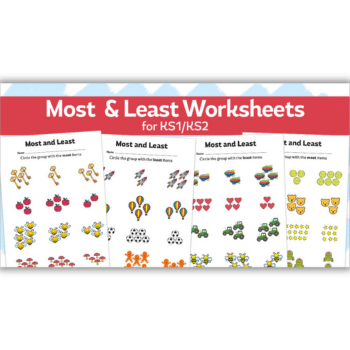We’ve designed these four illustrated most and least worksheets to help you gauge pupils’ ability to compare and contrast visual quantities.
The concept of “most” and “least” is woven into several Key Stages, beginning with the Early Years Foundation Stage (EYFS) and continuing through Key Stage 1 and Key Stage 2.
Most and least in the EYFS
In the EYFS, children start to develop an understanding of “most” and “least” through various activities and play. We often introduce these concepts informally and contextually. For example:
- Counting and comparing: You might ask children to count objects and determine which group has the most or least items.
- Everyday language: During activities such as snack time, children might discuss who has the most or least fruit.
- Sorting and grouping: Activities might involve sorting objects and discussing which groups have the most or least items.
Most and least in KS1
In KS1, the national curriculum for mathematics explicitly includes objectives related to understanding and using the concepts of “most” and “least”.
These concepts are part of the broader topics of number and place value, as well as statistics. For example:
- Number and place value: Children learn to compare and order numbers, identifying the greatest and smallest numbers in a set.
- Statistics: Children begin to interpret simple data sets, determining which categories have the most or least entries. They might use pictograms, bar charts, and tables to represent this data visually.
Specific objectives
Here are a few specific examples from the national curriculum:
- Year 1: Pupils should be taught to identify and represent numbers using objects and pictorial representations, including the number line, and use the language of “equal to,” “more than,” and “less than.”
- Year 2: Pupils should be taught to compare and order numbers from 0 up to 100; use <, >, and = signs.
Download Year 1 maths worksheets, Year 2 maths worksheets and our times tables worksheets bumper pack.














